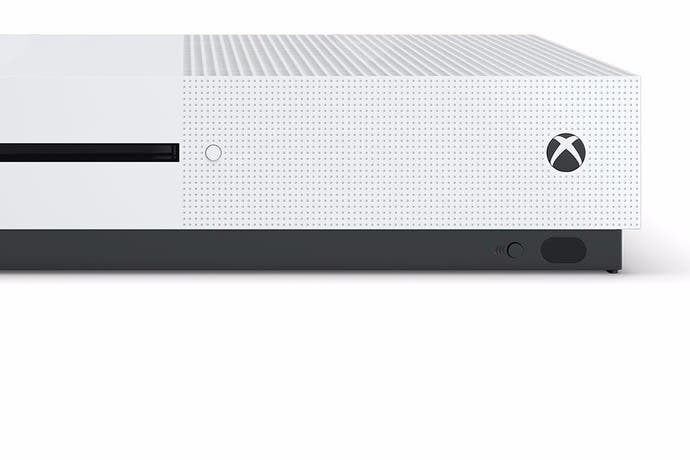Xbox One S performance boost revealed
The new console has a faster GPU and we've benchmarked it.
Xbox One S releases today and we finally have detailed data on exactly how the new console is faster than the original model. What's more, we've had access to production hardware for several days now, meaning we can test it. The bottom line is this: Xbox One S has a GPU clock-speed of 914MHz, up from 853MHz in the older unit. That's a 7.1 per cent increase and ESRAM bandwidth increases in line, taking that up to 218GB/s effective. Some games see no difference - others run noticeably faster.
As you can read in today's extensive Xbox One S tech interview, the GPU 'overclock' is one of a number of enhancements in a new system-on-chip (SoC) package that adds support for 4K HDR media and gaming. According to Microsoft, upclocking the graphics core is needed to support rendering real-time non-HDR versions of the game for the GameDVR feature, streaming and screenshots. The firm could have disabled it for non-HDR titles, but they chose not to - it's effectively a small, bonus value-added feature. In essence, the difference is rather like a factory overclocked PC graphics card compared to a stock model. By and large, Xbox One S runs like a standard console, but there are scenarios where the improvement is dramatic - far more so than we envisaged when Microsoft supplied the spec.
"Some games (ones that utilise dynamic resolution and/or unlocked frame-rates) may see a very minor performance improvement," says Microsoft's Albert Penello, senior director of product management and planning. "Our testing internally has shown this to be pretty minor, and is only measurable on certain games, so we didn't want to make it a 'selling point' for the new console."
But should it have been? In the video below, you'll see the results of our own extensive testing, but the bottom line is this. At worst, Xbox One S operates exactly like the standard Xbox One. At best, we saw a 9fps 'in the moment' differential between both consoles running the same content. As Penello says, the difference presents most strongly in games with an unlocked frame-rate, but the bottom line is that even your standard 30fps capped title will see improvement if the original Xbox One hardware can't meet the performance target.
First up, a quick note on our testing profile. We used a launch Xbox One unit provided by Microsoft, along with a 2TB version of the new Xbox One S. In order to ensure parity, all titles were run from a 250GB Samsung SSD running in an external caddy over USB 3.0. The idea here is straightforward enough - to remove storage as a potential bottleneck and concentrate performance on the capabilities of the processor.
We kick off with a game we chose in order to highlight the maximum possible potential of the spec boost. Project Cars aims for 60fps, but in a rain-lashed Monaco stacked up with vehicles, it rarely achieves it. A heavy GPU load then, with lashings of bandwidth-intensive alpha effects - which we would assume are processed via ESRAM. Using the game's replay feature we can directly copy the rendering load across sessions. And the result? A seven per cent improvement may not sound immense, but this is averaged across the run. In the moment differentials can be as high as 5fps.
Restarting the replay from the third-person chase cam view - a gameplay angle - the performance increase rises to 11 per cent, and an in-the-moment max delta of 9fps. Now, examination of the footage does see a variation in the deployment of alpha effects - the storm is randomised to an extent - but the improvement is considerable, and repeatable. This is the spec boost at its greatest in a scenario we crafted to make the most of the Xbox One's faster clocks, but regardless, this is not insignificant.

| Xbox One S | Xbox One | |
|---|---|---|
| CPU | 1.75GHz AMD Jaguar eight-core | 1.75GHz AMD Jaguar eight-core |
| GPU | 12 Compute Units | 12 Compute Units |
| GPU Clock | 914MHz | 853MHz |
| Compute Performance | 1.4TF | 1.31TF |
| ESRAM Bandwidth | 219GB/s | 204GB/s |
Our other 'go to' game is Io Interactive's Hitman. It has the option to lock at 30fps or run completely unlocked, albeit with v-sync engaged. In the past we've suggested it's the closest thing we have to a console benchmark when comparing PS4 and Xbox One, showing the strengths and weaknesses of both boxes. In a direct, like-for-like cut-scene comparison, the Xbox One S is 6.1 per cent faster than its predecessor. And although the gameplay comparison isn't 100 per cent locked in the way we would like, the differential there increases to 8.1 per cent.
Now at this point, you may be thinking that Microsoft really should be thinking twice about dismissing this as a selling point. However, the improvement to performance is highly context sensitive. Not all performance limitations are GPU-based in nature. Returning to Hitman, the Paris stage is NPC heavy and all of those characters, simulated AI and animation don't come cheap. The performance limitation here is CPU-based, and watching the footage unfold it's interesting to see the fits and starts with One S as it pulls ahead of Xbox One, then returns to parity in a fascinating battle of the bottlenecks. It should be noted that this stage also sees Xbox One pull ahead of PlayStation 4 by a margin of around nine per cent.
Similarly, with Resident Evil 5 Remastered, the game aims for 1080p60 but regularly fails to attain it. There is a performance uplift on Xbox One S but only in areas where we are GPU-bound - which is clearly the minority in our tests clips taken from the beginning of the game. Here, the average performance uplift drops to just 2.5 per cent across the test sample. The takeaway here is that while GPU clocks have increased with a knock-on effect on ESRAM bandwidth, CPU is unchanged - as Microsoft clarifies in our Xbox One S tech interview.
Thus far, we've achieved some truly impressive - and not so impressive - results by directly addressing games with rendering scenarios where Microsoft says we could see an improvement (dynamic resolution games are very hard to test but yes, we should see fewer resolution drops in the heat of the action). But what about games that don't target 60fps? What about titles that run with a capped 30fps frame-rate? We chose two titles here for our testing here: Rise of the Tomb Raider and Batman: Arkham Knight.
With Tomb Raider, the village area in the Geothermal Valley allows us to reproduce dips beneath the target 30fps and here we see Xbox One S ironing out some of the drops during traversal with fewer pockets of screen-tear. In an NPC-packed briefing, performance continually drops to 28fps on Xbox One, while the S holds the 30fps line perfectly. It's not a game-changer but it adds a small layer of additional polish to a great title.
Arkham Knight is more curious. Again, we see less screen-tear in a like-for-like engine-driven cinematic as we pan across Gotham City, but the most illuminating section comes from the notorious Batmobile sections, which see both tearing and conspicuous drops beneath 30fps. Frame-rate increases across our test clip by four per cent, tearing decreases, but more notable is the reduction in stutter on frame-times. The game feels a touch smoother. It's not a revelation, and there's no boost to a locked 30fps, but there is an improvement.
Our penultimate test is a bust. Fallout 4 could surely use some of that extra refinement offered by the Xbox One S's GPU boost, but the end result is an uncanny match between the two iterations of Xbox One hardware. In some cases, the frame-drops are literally identical, suggesting a memory or CPU bottleneck - something the additional GPU power is not going to address.
And finally, we did a little testing on Xbox One backward compatibility. Again, you're far more likely to see the improvement here on 60fps titles that can't quite hit the performance target consistently, but it is there - sub-30fps dips in our Alan Wake's American Nightmare testing are much reduced on the Xbox One S. GPU power isn't really the issue with Xbox One back-compat, it's more the virtualisation of Xbox 360's CPU cores, so we suspect that boosts to games with real performance issues (Mass Effect, Halo Reach etc) are unlikely, but it's good to know that the graphics clock boost does indeed apply to all areas of the system.
In conclusion, there are clearly scenarios where the increased GPU provision and ESRAM memory bandwidth hand in substantial 'in the moment' gains, but equally, in a world of capped 30fps titles, the boost to graphics provision counts is less impactful, taking the form of a closer lock to the target frame-rate in GPU-bound scenarios. The increased performance in the new console is fascinating to highlight in benchmarks, but in the 'real world', Xbox One S simply adds an additional layer of consistency - some will notice it and appreciate it, others may want it just because it's there, but equally, it's fair to say that many more may not notice it at all.
However, with the move to TSMC's 16nm FinFET production process for the revised Xbox One SoC, we can't help but wonder just how far this processor could overclock given the remarkable increase to GPU performance seen in Nvidia's Pascal processors, fabricated on the same node. And what if those two extra compute units on the design were re-activated? We'll probably never know, and of course it'll never happen, but we'd love to test any upclocked prototypes Microsoft might have lying around its R&D labs. In the meantime, if you're interested in our take on the console as a whole, check out our full Xbox One S review and round-up on everything we know about Xbox One S.











